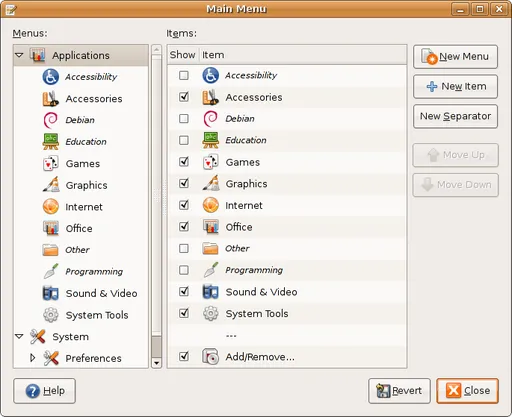Sometimes, after installing applications via APT on Linux, you may find that the apps do not appear in the desktop environment menu (like GNOME). This can be confusing and inconvenient, especially for users accustomed to a GUI. In this post, we briefly discuss the causes of this issue and introduce a tool called Alacarte that can help resolve it.
Why Aren't Apps Displayed in the Menu?
Apps installed via APT typically create .desktop files in the /usr/share/applications directory to integrate with the desktop menu system. However, there are several reasons why an app might not appear in the menu:
- If the installed app does not include a
.desktopfile or it exists in an incorrect path - Even if a
.desktopfile exists, it may be set to hidden withNoDisplay=trueorHidden=true - Compared to Flatpak/Snap, APT packages may require manual configuration for menu integration
In such cases, using a menu editing tool called Alacarte, users can manually register their apps in the menu.
What is Alacarte?
Alacarte is the official menu editor used in the GNOME desktop environment. Users can add, modify, and delete menu items, and freely set execution commands or icons.
- Name:
alacarte - Package Name:
alacarte - After installation, run it as: "Main Menu" (or via the
alacartecommand)
How to Install
Alacarte can be installed on most GNOME-based distributions, including Ubuntu, Debian, and Pop!_OS.
sudo apt update
sudo apt install alacarte
After installation, you can run alacarte in the terminal or find "Main Menu" in the app search to execute it.
Summary of Alacarte Usage
- Run
alacarte - Select the desired category from the left (e.g., Internet, Utilities, etc.)
- Click “New Item” on the right
- Specify the name, command, and icon, then save
- If needed, items can be moved or toggled between checked/unchecked
💡 When entering the command, you should input a CLI command that can be directly executed, specifying the name of the executable file located in the
/usr/binpath.
When is Alacarte Useful?
- When the apps installed via APT are not automatically registered in the app menu
- For Wine apps that do not automatically create a
.desktopfile - When you want to customize the icon or name of a specific app
- When you need to register development scripts or command-line apps in the GUI menu
Conclusion
APT is a powerful package system, but sometimes GUI integration requires additional adjustments from users. In such cases, Alacarte can provide a simple and effective solution. It's a useful tool, especially for those using Linux in a GUI environment, so it's recommended to install and utilize it.

When you run Alacarte, you can edit or add menu items category-wise through an interface that looks like the one above.

There are no comments.